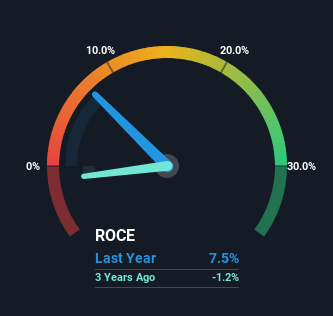Returns On Capital Are Showing Encouraging Signs At BIO-UV Group (EPA:ALTUV)
What trends should we look for it we want to identify stocks that can multiply in value over the long term? Firstly, we'll want to see a proven return on capital employed (ROCE) that is increasing, and secondly, an expanding base of capital employed. Put simply, these types of businesses are compounding machines, meaning they are continually reinvesting their earnings at ever-higher rates of return. Speaking of which, we noticed some great changes in BIO-UV Group's (EPA:ALTUV) returns on capital, so let's have a look.
Return On Capital Employed (ROCE): What Is It?
If you haven't worked with ROCE before, it measures the 'return' (pre-tax profit) a company generates from capital employed in its business. The formula for this calculation on BIO-UV Group is:
Return on Capital Employed = Earnings Before Interest and Tax (EBIT) ÷ (Total Assets - Current Liabilities)
0.075 = €4.1m ÷ (€74m - €19m) (Based on the trailing twelve months to December 2022).
So, BIO-UV Group has an ROCE of 7.5%. Even though it's in line with the industry average of 6.8%, it's still a low return by itself.
Check out our latest analysis for BIO-UV Group

Above you can see how the current ROCE for BIO-UV Group compares to its prior returns on capital, but there's only so much you can tell from the past. If you'd like, you can check out the forecasts from the analysts covering BIO-UV Group for free.
How Are Returns Trending?
We're glad to see that ROCE is heading in the right direction, even if it is still low at the moment. The numbers show that in the last five years, the returns generated on capital employed have grown considerably to 7.5%. Basically the business is earning more per dollar of capital invested and in addition to that, 263% more capital is being employed now too. So we're very much inspired by what we're seeing at BIO-UV Group thanks to its ability to profitably reinvest capital.
On a side note, we noticed that the improvement in ROCE appears to be partly fueled by an increase in current liabilities. The current liabilities has increased to 25% of total assets, so the business is now more funded by the likes of its suppliers or short-term creditors. Keep an eye out for future increases because when the ratio of current liabilities to total assets gets particularly high, this can introduce some new risks for the business.
What We Can Learn From BIO-UV Group's ROCE
To sum it up, BIO-UV Group has proven it can reinvest in the business and generate higher returns on that capital employed, which is terrific. Astute investors may have an opportunity here because the stock has declined 27% in the last five years. With that in mind, we believe the promising trends warrant this stock for further investigation.
On a final note, we found 4 warning signs for BIO-UV Group (1 shouldn't be ignored) you should be aware of.
While BIO-UV Group may not currently earn the highest returns, we've compiled a list of companies that currently earn more than 25% return on equity. Check out this free list here.
Valuation is complex, but we're here to simplify it.
Discover if BIO-UV Group might be undervalued or overvalued with our detailed analysis, featuring fair value estimates, potential risks, dividends, insider trades, and its financial condition.
Access Free AnalysisHave feedback on this article? Concerned about the content? Get in touch with us directly. Alternatively, email editorial-team (at) simplywallst.com.
This article by Simply Wall St is general in nature. We provide commentary based on historical data and analyst forecasts only using an unbiased methodology and our articles are not intended to be financial advice. It does not constitute a recommendation to buy or sell any stock, and does not take account of your objectives, or your financial situation. We aim to bring you long-term focused analysis driven by fundamental data. Note that our analysis may not factor in the latest price-sensitive company announcements or qualitative material. Simply Wall St has no position in any stocks mentioned.
About ENXTPA:ALTUV
BIO-UV Group
Designs, manufactures, and markets ultraviolet light water treatment and surface disinfectant devices for individuals and professionals in France, rest of Europe, Asia, the Middle East, the United States, and internationally.
Flawless balance sheet with acceptable track record.
Market Insights
Community Narratives



